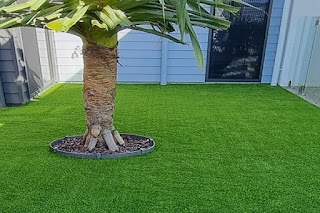The Rise of Artificial Grass in Modern Landscaping And Unveiling the Green Revolution
In the realm of landscaping and outdoor aesthetics, a revolutionary transformation has been quietly taking place under our feet. The lush, vibrant lawns that adorn our homes, parks, and public spaces are no longer exclusively nurtured by Mother Nature. Instead, they owe their verdant allure to the innovation of artificial grass, also known as synthetic grass or turf. As this eco-friendly alternative gains momentum, it's time to explore the burgeoning trend and its implications for the future of landscaping.
Artificial grass, once associated
with sports arenas and commercial spaces, has transcended its utilitarian
origins to become a staple in residential landscaping. Its appeal lies not only
in its evergreen appearance but also in its practical advantages. Unlike
natural grass, which demands regular watering, mowing, and chemical treatments
to maintain its pristine condition, synthetic grass offers a low-maintenance solution
without compromising on aesthetics.
One
of the primary drivers behind the surge in artificial grass adoption is its
remarkable resemblance to natural grass. With advancements in technology,
modern synthetic turf closely mimics the texture, color, and density of real
grass, creating an illusion so convincing that it's often indistinguishable to
the naked eye. This realism, coupled with the convenience it offers, has led
homeowners, businesses, and municipalities alike to embrace artificial grass as
a viable landscaping option.
Beyond
its visual appeal and ease of upkeep, artificial grass presents a compelling
case for environmental sustainability. In an era where water scarcity and
environmental conservation are pressing concerns, the water-saving potential of
synthetic turf cannot be overstated. By eliminating the need for irrigation,
artificial grass helps reduce water consumption, alleviate strain on local
water supplies, and mitigate the environmental impact associated with
traditional lawn maintenance practices.
Moreover,
artificial grass offers a solution to the challenges posed by extreme weather
conditions and climate change. Resilient and durable, synthetic turf remains
unaffected by fluctuations in temperature, sunlight exposure, or heavy foot
traffic, ensuring year-round greenery regardless of external factors. This
resilience makes it particularly well-suited for regions prone to drought,
harsh winters, or soil erosion, where natural grass struggles to thrive.
In
addition to its practical benefits, artificial grass contributes to resource
conservation by minimizing the use of pesticides, fertilizers, and other
chemicals commonly employed in lawn care. By reducing chemical runoff and
contamination of soil and waterways, synthetic turf promotes a healthier
environment for humans, pets, and wildlife alike.
Despite
its many advantages, the widespread adoption of artificial grass is not without
its challenges and considerations. Critics often raise concerns about the
environmental impact of manufacturing and disposing of synthetic turf, as well
as its potential to exacerbate urban heat island effects. Additionally, some
argue that the loss of natural habitats and biodiversity associated with
artificial grass installations may outweigh its water-saving benefits in
certain contexts.
As
we navigate these complexities, it's essential to approach the adoption of
artificial grass with careful consideration of local ecosystems, climate
conditions, and long-term sustainability goals. While synthetic turf offers
undeniable advantages in terms of aesthetics, convenience, and resource
conservation, its implementation should be guided by principles of
environmental stewardship and responsible land management.
The rise of artificial grass represents a paradigm shift in the world of landscaping, offering a compelling alternative to traditional lawn care practices. By marrying innovation with environmental consciousness, synthetic grass has emerged as a versatile solution for creating lush, green spaces that endure the test of time. As we embrace the green revolution, let us tread thoughtfully, mindful of the delicate balance between progress and preservation in our quest for sustainable landscapes.




Comments
Post a Comment